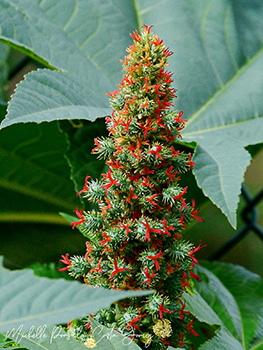This post is also available in: Dutch (below)
It does not really matter if this plant was introduced on the island because of its ornamental value, it’s applications in the beauty and medicinal practices or as an involuntary introduction, fact is the plant was introduced and has now a firm presence on the island. We know it as the Castor bean plant or Castor oil plant, and it is scientifically called Ricinus communis. In Papiamento it has the descriptive name Karpata or Carpata in Papiamento (Aruba) and that has a good reason. The seeds that form in the fruits produced by the plant have the uncanny appearance of huge bloated grey tick filled with blood.

The famous Castor bean plant has been bred in several varieties according to its medical or ornamental applications. The ones we find on Aruba, Bonaire and Curaçao grow into shrubs and sometime small trees of a couple of meters high, with large dark green leaves and flower cones that look like tiny Christmas trees.
If you look closely at the flower cone on the photo you will see that it consists of 2 different kinds of flowers; creamy rounded ones on the underside and reddish ones on the upper side. This is an unisexual plant that produces both male and female flowers on the same plant. But it has a very interesting adaptation to prevent the wind from auto fertilizing it with its own pollen. The position of the flowers are indicative, the pollen loaded ones are below and as such make it more difficult to auto fertilize in the case both sexes of flowers ripen at the same time. Usually the different sexes will not flower at the same time, but with some days between them to prevent auto fertilization.
English name: Castor bean plant or Castor oil plant
Papiamentu/Papiamento name: Karpata (Bonaire, Curaçao), Carpata (Aruba)
Scientific name: Ricinus communis
Family: Euphorbiaceae (Spurge family)
Occurrence (ABC islands): Aruba, Bonaire and Curaçao (introduced)
TOXICITY: It is important to mention that the seeds or beans contain the highly toxic ricin. Do not chew on them or ingest them.

Wilde bloemen: Wonderolieboom
Het maakt niet echt uit of deze plant op het eiland is geïntroduceerd vanwege zijn sierwaarde, zijn toepassingen in de schoonheids- en medicinale praktijken of als een onvrijwillige introductie, feit is dat de plant is geïntroduceerd en nu stevig genaturaliseers is op het eiland. We kennen de plant als de wonderolieplant of wonderboom, en het wordt wetenschappelijk Ricinus communis genoemd. In het Papiaments heeft het de beschrijvende naam Karpata, Carpata in het Papiamento van Aruba, en dat is niet voor niets. De zaden die zich vormen in de vruchten die door de plant worden geproduceerd, hebben het griezelige uiterlijk van een grote, volgevreten grijze teek gevuld met bloed.

De beroemde wonderolie plant is in verschillende variëteiten gekweekt op basis van zijn medische of sierlijke toepassingen. De varianten die we op Aruba, Bonaire en Curaçao vinden, groeien uit tot struiken en soms kleine bomen van een paar meter hoog, met grote donkergroene bladeren en bloemkegels die lijken op kleine kerstbomen.
Als je goed kijkt naar de bloemkegel op de foto, zie je dat deze bestaat uit 2 verschillende soorten bloemen; romige ronde aan de onderkant en roodachtige aan de bovenkant. Dit is een eenslachtige plant die zowel mannelijke als vrouwelijke bloemen op dezelfde plant produceert. Maar het heeft een zeer interessante aanpassing om te voorkomen dat de wind het automatisch bevrucht met zijn eigen stuifmeel. De positie van de bloemen is indicatief, de met stuifmeel beladen bloemen zitten eronder en maken het als zodanig moeilijker om zichzelf te bevruchten in het geval dat beide geslachten van de bloemen tegelijkertijd rijpen. Meestal bloeien de verschillende geslachten niet tegelijkertijd, maar met enkele dagen ertussen om zelfbevruchting te voorkomen.
Nederlandse naam: Wonderolieboom of Wonderboom
Papiamentse naam: Karpata (Bonaire, Curaçao), Carpata (Aruba)
Wetenschappelijke naam: Ricinus communis
Familie: Euphorbiaceae (Wolfsmelkfamilie)
Voorkomen (ABC eilanden): Aruba, Bonaire en Curaçao (Geïntroduceerd)
TOXICITEIT: Het is belangrijk om te vermelden dat de zaden of bonen de zeer giftige ricine bevatten. Kauw er niet op en slik ze niet in.